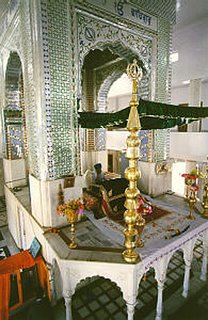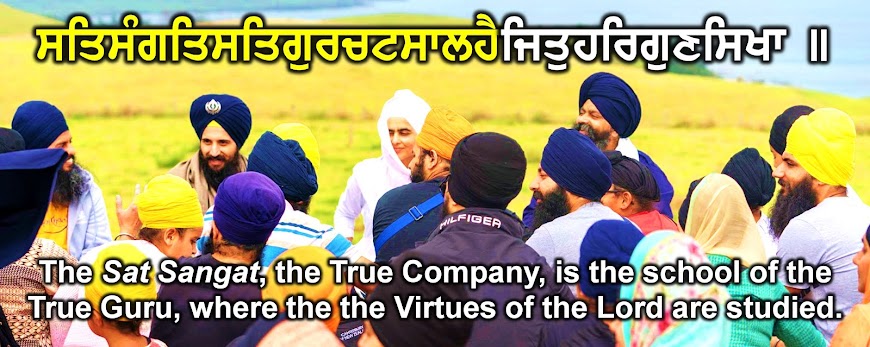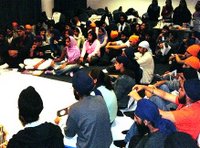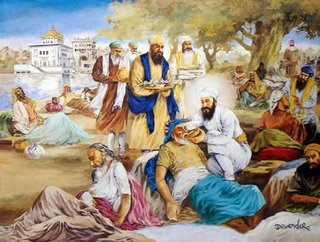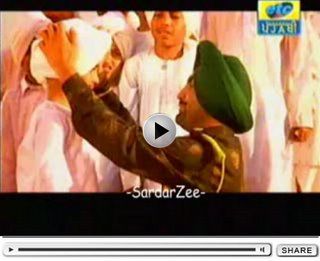
Yesterday I went to a training course on domestic violence at St. Thomas Hospital, which I attended as part of being a Sikh volunteer for the Hospital's Spiritual Care & Chaplaincy department. It was a very interesting training, and discovered very GRIM and DEPRESSING statistics on domestic violence. Then in the training session the trainer played an audio recording of a lady who survived domestic violence (but was nearly shot-dead by her husband). It was FREAKY. The lady was given a SAFE HOUSE to live in. Next door was a derilect building. The worst thing was that the husband found out where his wife was living and he climbed through into the house through the derelict building. He came into the house through the LOFT and terrorised this poor lady. I just put my hands together and kept saying
"WAHEGURU". No other word could comprehend what this woman went through. The man would HARRASS the lady and steal her clothes, house keys and food. She thought she was going mad. He then got a shotgun and forced her back home. Eventually (THANK GOD) she rang the police and the man was put into prison. Rab Rakha!
Later on the trainer mentioned an example of a Panjabi lady she came across. Apparently the man was from UK and he married from Panjab. He wanted power of his wife and wanted to control her life. When she asked if she could learn English, he would beat her. If she were seen asking English words from relatives, he would beat her. Apparently he didn't want her to pick up English so that she would remain DEPENDENT on him and he could do whatever he wanted to her and she would not have the confidence to tell anyone. Very sad! Rab Rakha.

The trainer pointed out that the main cause for Domestic violence is "POWER & CONTROL." Gurbaani time and time tells us the ill effects of HANKAAR (EGO):
ਗਰਬੰਤਿ ਨਾਰੀ ਮਦੋਨ ਮਤੰ ॥
garbant naaree madon mataN.
Those who are proud, and intoxicated with the pleasures of sex,
ਬਲਵੰਤ ਬਲਾਤ ਕਾਰਣਹ ॥
balvant balaat kaarNeh.
and asserting their power over others,
ਚਰਨ ਕਮਲ ਨਹ ਭਜੰਤ ਤ੍ਰਿਣ ਸਮਾਨਿ ਧ੍ਰਿਗੁ ਜਨਮਨਹ ॥
charan kamal neh bhajant triN samaan Dhrig janamneh.
never contemplate the Lord Waheguru's Lotus Feet. (For this reason) their lives are as worthless as straw, and deemed as cursed.
ਹੇ ਪਪੀਲਕਾ ਗ੍ਰਸਟੇ ਗੋਬਿੰਦ ਸਿਮਰਣ ਤੁਯੰ ਧਨੇ ॥
he papeelkaa grestte gobind simran tu-yaN Dhane.
You are as tiny and insignificant as an ant, but if you have the wealth of Simran, the Lord's Meditation then (despite being tiny) you shall become great.
ਨਾਨਕ ਅਨਿਕ ਬਾਰ ਨਮੋ ਨਮਹ ॥੬੩॥
naanak anik baar namo nameh. 63.
O Nanak! Bow in humble worship to Waheguru, countless times, over and over again. 63.
(Ang 1359)
Guru jee explains the above shabad that person who does Waheguru's Simran (meditation) and keeps humility is better than the person who forgets Waheguru and shows power & control over others in ego. The solution is NAAM and SUBMITTING to Waheguru's HUKAM (Will). Unfortunately Man thinks that he is God. He may not say it, but he acts like it. We say
"ITS MY LIFE" (you hear many children say this). However, we don't realize its NOT OUR LIFE, its WAHEGURU'S LIFE which is a GIFT TO US. Until we don't realize this, then we do not escape this intoxication of power & control, which we egotistically exercise over others and bully them. We have to realise we are NOTHING and Waheguru is EVERYTHING, we are INSIGNIFICANT and Waheguru is GREATEST, then we can truly enjoy peace, tranquillity and harmony in the household and everyday life.

On the way back from the Hospital I went to the library because I had to return some books. I was crossing Waterloo Bridge and there was a GUSH of WIND. It was VERY WINDY. Everyone was feeling the POWER of the windy breeze. As I walking across the bridge I was doing Simran and repeating
"VAAHE-GUROO... VAAHE-GUROO... VAAHE-GUROO." How amazing! God is Great! In Aasa Di Vaar it says:
ਭੈ ਵਿਚਿ ਪਵਣੁ ਵਹੈ ਸਦਵਾਉ ॥
bhai vich pavaN vahai sadvaa-o.
In the Awe of God, the wind and breezes ever blow.
(Ang 464)
I thought to myself that people don't acknowledge God's existence and say
"PROVE IT, I CAN'T SEE GOD." However, I thought,
"LOOK ITS WINDY. SHOW ME the wind!" You can't see the wind, but you definitely EXPERIENCE the wind. Waheguru is not sitting in Heaven (as believed by mainstream Christianity), sitting in the Seventh Sky above Earth (as believed by mainstream Islam) or dwelling in idols (as believed by mainstream Hinduism). Waheguru is here, EVERYWHERE and in dwelling amongst His Creation.
ਗੁਰਮੁਖਿ ਧਰਤੀ ਗੁਰਮੁਖਿ ਪਾਣੀ ॥
gurmukh Dhartee gurmukh paaNee.
The Gurmukh sees the Lord Waheguru on the earth, and the Gurmukh sees Him
in the water.
ਗੁਰਮੁਖਿ ਪਵਣੁ ਬੈਸੰਤਰੁ ਖੇਲੈ ਵਿਡਾਣੀ ॥
gurmukh pavaN baisantar khelai viddaaNee.
The Gurmukh sees Him in wind and fire; such is the wonder of His Play.
(Ang 117)
The same wind and air which we CANNOT SEE, destroys homes, moves the waves in the river & seas, presses against people's face, and causes trees to shake. Look at the POWER and BEAUTY of Waheguru who CREATES, SUSTAINS and DWELLS within this magnificent NATURE and Universe. ਕਮਾਲ ਹੈ (Kamaal Hai)! VAAH (Wonderful) comes out of the mouth!
ਏਕੁ ਅਚਾਰੁ ਰੰਗੁ ਇਕੁ ਰੂਪੁ ॥
eik achaar, rang ik roop.
The One Lord Waheguru is in all actions, colours and forms.
ਪਉਣ ਪਾਣੀ ਅਗਨੀ ਅਸਰੂਪੁ ॥
pauN paaNee agnee asroop.
Waheguru manifests in many shapes through wind, water and fire.
(Ang 930)
It was beautiful. If you just become part of the EXPERIENCE and let your breath go with the breeze it's great! Deeply breathe in, and breathe out. You can hear the vibration of
"VAAHE-GUROO... VAAHE-GUROO... VAAHE-GUROO" being whispered by the windy breeze! It reminds me of Michael Jackson's "EARTH" song, which came out in 1995 (Ps. I remember the song from my school days!). In the song video (according to what I remember) Michael Jackson is standing there with his arms up and facing the breezy wind and embracing nature.

Guru Nanak Jee captures this feeling of AWE and ECSTASY through experiencing the Creation of Waheguru in Gurbaani:
ਵਿਸਮਾਦੁ ਪਉਣੁ ਵਿਸਮਾਦੁ ਪਾਣੀ ॥
vismaad pauN vismaad paaNee.
Wonderful is the wind, wonderful is the water.
(Ang 464)

You can see the beauty of the GUR-MANTR, the Divine Word
"VAAHE-GUROO" - ਵਾਹਿਗੁਰੂ
. It is an ecstatic expression of awe and wonderment -
"WONDROUS DISPELLER OF DARKNESS." With each breath in and out, a Gursikh breathes this ecstatic expression (given as a gift by the True Guru), which attunes the Gursikh’s mind and consciousness to the Wonder and Glory of God.
As I was crossing the bridge I could see the worried faces of people as their hair blew up and across. It reminded me of when I had my hair cut. I used to keep a side parting. It would be a nightmare when sitting in the car and the window was down (especially in India), because by chance if I was sitting on the wrong side, then the wind would blow in opposite direction to my side parting, MESSING UP MY HAIR-STYLE. lol. It was humorous looking at everyone's hair being blown away and then thinking
"Rab Da Shukar that I wear a Dastaar!" :)

